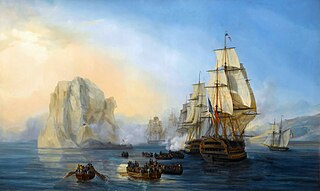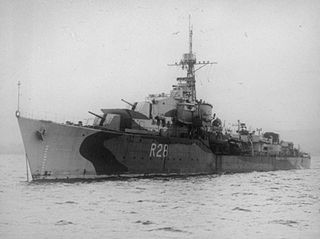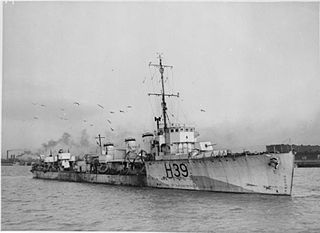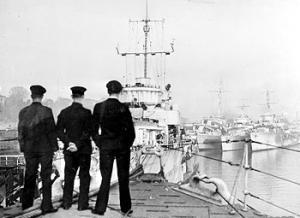
HMS Kingston was a K-class destroyer of the Royal Navy.

A stone frigate is a naval establishment on land.

The Captain class was the designation given to 78 frigates of the Royal Navy, constructed in the United States, launched in 1942–1943 and delivered to the United Kingdom under the provisions of the Lend-Lease agreement. They were drawn from two classes of the American destroyer escort classification: 32 of the GMT (Evarts) Type and 46 of the TE (Buckley) Type. Upon reaching the UK the ships were substantially modified by the Royal Navy, making them distinct from the US Navy destroyer escort ships.

Captain John Egerton Broome DSC, also known as Jackie Broome, was a Royal Navy officer who served in both World Wars. He commanded the escort group of the ill-fated Arctic Convoy PQ 17 in 1942. After the Second World War, he became a writer and illustrator.

HMS Electra was a one of nine E-class destroyers built for the Royal Navy during the 1930s. Sunk in the Battle of the Java Sea, Electra was a witness to many naval battles, including the Battle of the Denmark Strait and the sinking of Prince of Wales and Repulse. The ship's wreck was discovered in 2003 and had been badly damaged by illegal salvagers by 2016.

HMD Bermuda was the principal base of the Royal Navy in the Western Atlantic between American independence and the Cold War. The Imperial fortress colony of Bermuda had occupied a useful position astride the homeward leg taken by many European vessels from the New World since before its settlement by England in 1609. French privateers may have used the islands as a staging place for operations against Spanish galleons in the 16th century. Bermudian privateers certainly played a role in many English and British wars following settlement, with its utility as a base for his privateers leading to the Earl of Warwick, the namesake of Warwick Parish, becoming the most important investor of the Somers Isles Company. Despite this, it was not until the loss of bases on most of the North American Atlantic seaboard threatened Britain's supremacy in the Western Atlantic that the island assumed great importance as a naval base. In 1818 the Royal Naval Dockyard, Bermuda officially replaced the Royal Naval Dockyard, Halifax, as the British headquarters for the North America Station (which would become the North America and West Indies Station after absorbing the Jamaica Station in 1830.

Londonderry Port, now operating as Foyle Port, is a port located on Lough Foyle in Northern Ireland. It is the United Kingdom’s most westerly port and an important northerly port on the island of Ireland. The current port is at Lisahally, County Londonderry, though historically the port was upriver in the city of Derry itself. It is operated by the Londonderry Port and Harbour Commissioners, whose former offices, just north of the city's walls, are now a museum.

HMS Verulam was a V-class destroyer of the British Royal Navy that saw service during the Second World War.

HMS Eclipse was an E-class destroyer of the Royal Navy that saw service in the Atlantic, Arctic, and Mediterranean theatres during World War II, until sunk by a mine in the Aegean Sea on 24 October 1943.

HMS Badsworth(pennant number L03) was an escort destroyer of the Type II Hunt class. The Royal Navy ordered Badsworth's construction three months after the outbreak of the Second World War. Cammell Laird laid down her keel at their Birkenhead yard on 15 May 1940, as Admiralty Job No. J3260. After a successful Warship Week national savings campaign in March 1942, Badsworth was adopted by the civil community of Batley, then in the West Riding of Yorkshire. The ship was named after a fox-hunt in Yorkshire.

An Escort Group consisted of several small warships organized and trained to operate together protecting trade convoys. Escort groups were a World War II tactical innovation in anti-submarine warfare by the Royal Navy to combat the threat of the Kriegsmarine's "wolfpack" tactics. Early escort groups often contained destroyers, sloops, naval trawlers and, later, corvettes of differing specifications lacking the ability to maneuver together as a flotilla of similar warships, but rigorously trained in anti-submarine tactics to use teamwork emphasizing the unique sensors, weapons, speed, and turning radius of each ship. The development of these 'escort groups' proved an effective means of defending shipping convoys through the Battle of the Atlantic.
HMS Hargood (K582) was a Captain-class frigate which served in the Royal Navy during World War II. Laid down as a Buckley class destroyer escort originally intended for the United States Navy, she was transferred to the United Kingdom under the terms of Lend-Lease before she was finished in 1944, serving in the Royal Navy from 1944 to 1946. She was returned to the U.S. Navy in 1946 and sold for scrapping in 1947.

The fourth HMS Spragge (K572) and third ship of the name to enter service was a British Captain-class frigate of the Royal Navy in commission during World War II. Originally constructed as a United States Navy Buckley-class destroyer escort, she served in the Royal Navy from 1944 to 1946.

HMS Vanquisher (D54) was a V-class destroyer of the British Royal Navy that saw service in World War I and World War II.

HMS Venomous (ex-Venom), was a Modified W-class destroyer of the British Royal Navy that saw service in the Russian Civil War and World War II.

HMS Versatile (D32) was an Admiralty V-class destroyer of the British Royal Navy that saw service in World War I, the Russian Civil War, and World War II.

The second HMS Wivern, was a Modified W-class destroyer of the British Royal Navy that saw service in World War II.

HMS Lowestoft was a Grimsby-class sloop of the Royal Navy. Built at Devonport Dockyard in the 1930s, Lowestoft was launched in 1934 and commissioned later that year. She served on the China Station, based at Hong Kong until the outbreak of the Second World War. Lowestoft served as a convoy escort during the war, both in the North Atlantic and off the west coast of Africa.

HMS Londonderry was a Grimsby-class sloop of the Royal Navy. Built at Devonport Dockyard in the 1930s, Londonderry was launched in early 1935 and commissioned later that year. She served in the Red Sea and the South Atlantic until the outbreak of the Second World War. Londonderry served as a convoy escort during the war, which she survived. The ship was sold for scrap in 1948.

HMS Alisma was a Flower-class corvette that served in the Royal Navy.



















